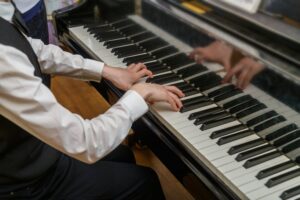This post is brought to you by one of our Piano Teachers!
Did you ever want to play the piano with vigorous speed? Perhaps you heard “Flight of the Bumblebee” for the first time and were in awe. Have you reached a stumbling block? How can a pianist learn to achieve velocity?
This topic is something that students may ask in their first lesson. What is the secret? A private piano instructor can help you and guide you along on your musical journey. Lessons in Your Home has qualified teachers that offer in-home and virtual lessons to students of all ages and levels.
The Mechanism for Speed
Fast muscle twitch fibers contribute to the finger’s ability to have precise and quick movements. Tap your fingers as rapidly as you can on a surface. Observe the natural quickness and lightness of your fingers. We are all born with reasonable coordination and agility, and our piano instructors can help young students discover their innate abilities!
The Supposed Weak Fourth Finger
Try lifting your fingers one at a time. You will find that your thumb, index, and middle fingers move with comfort. Next, try raising your ring finger and pinky. Now, the ring finger isn’t so easy! Since the fourth finger has no independent flexor, it moves in conjunction with the other fingers. Imagine a string is pulling your hand up and down when you play your fourth finger. I bet this feels easier! The key is to allow your ring finger to move along with the other fingers and establish a connection with the forearm.
The Brain/Body connection
It is easy to overdo physical exercises and work the fingers in a tense manner. Tension can be counterproductive. Remember that the fourth finger works in harmony with the other fingers. If you try to lift the fourth finger while locking your other fingers and muscles, this can cause carpal tunnel strain.
I think it’s important to incorporate mental practice. Try playing the piece in your mind. Can you hear every note? If not, listen to the score and try again. When you can hear the music internally, the body will respond. Technique and expression are one of the same. If your movements are efficient, you will play with great feeling. The reverse is true. When your heart is with the music, you will move with good technique.
Understanding the Music
I like to break down the musical score in several ways. For the beginning student, this can be understanding the notes and rhythmic variations. Subsequently, they dig deeper into the dynamics, phrasing, and expression. Get to know the composer. Learn about their life and character. What inspired them to write this piece of music?
Method Books
Working on techniques separate from repertoire is a satisfying pursuit. Method books are perfect for students to progress and see where they are. For beginner students, the Dozen a Day books are helpful. Each piece compares to a different exercise, such as Jumping, Skipping, and Running. Many other series encourage technique. Good publishers of such books include Leila Fletcher, Faber & Faber, and Alfred’s.
One of the best method books for building speed, coordination of the hands, and finger independence is The Virtuoso Pianist by Charles-Louis Hanon (1819-1900). A student can begin this work after one to three years of study. The first collection of exercises serves as the foundation for strong and independent fingers. Musically, they follow repetitious patterns easy to recognize and memorize. Part two includes all the major and minor scales and arpeggios. Finally, exercises 44-60 push the advanced pianist to achieve the highest level of velocity. This work will last a musician’s entire career.
Practice Tips
The key to building speed is to play fluidly, with perfect rhythm and ease of motion. Building speed takes time, patience, and desire. Start playing slowly until the passage becomes easy. Do not overpush. Focus on musicality. Understand how your body works in conjunction with the music. Remember the connection the fingers have with each other. A private instructor will help guide you towards your musical goals. With practice and determination, your fingers will not just run on the keyboard but fly.
If your young one is ready to start piano lessons, trust the best in the business today. Lessons In Your Home provides at home lessons that work with YOUR schedule. We provide 1 on 1, undivided attention so that your student can grow faster and more proficient as a musician. Reach out to us today to get started.
